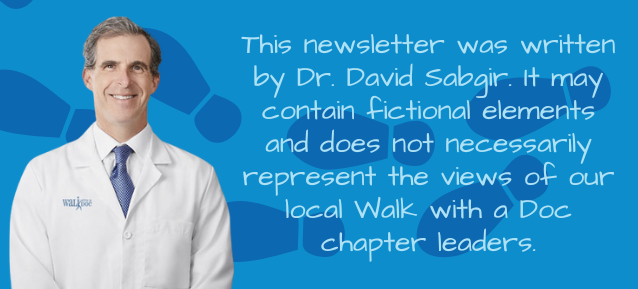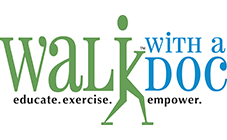Good morning!
We were with friends the other night when a couple of cardiology questions came up, and it reminded me how similar (and confusing!) some of these terms can be. At Walk with a Doc, we always strive to keep our members as knowledgeable as possible, and this seemed like a great platform to introduce or review some common heart-related terms.
As always, please remember that if you’re walking 150 minutes or more each week, most of what follows may be more for your curiosity than concern. Why? Because you’re already going a long way in reducing the risk factors listed below.
Physical Activity = Miracle Drug = Fountain of Youth
FAQs (We love this stuff!)
Risk factors come in two categories: modifiable and non-modifiable.
Major modifiable cardiac risk factors (can be influenced by lifestyle or medical treatment):
(a) Smoking
(b) High blood pressure
(c) High LDL (“bad” cholesterol)
(d) Low HDL (“good” cholesterol)
(e) Diabetes
(f) Physical inactivity
(g) Overweight or obesity
(h) Poor diet
(i) Sleep apnea
Non-modifiable risk factors:
(a) Age
(b) Family history
(c) Gender
(d) Ethnicity
Some terms:
1. Heart cath, angiogram, cardiac catheterization:
These are all the same thing. This is a diagnostic test, meaning we’re just “taking a look.” A skinny catheter is threaded over a wire introduced into the body, typically via the radial artery (about 50 to 60% of cases) or the femoral artery.
2. Stents:
Often described as looking like the spring inside a pen, stents act as tiny scaffolds inside blood vessels. They press plaque (atherosclerosis) against the vessel wall, allowing blood to flow more freely.
3. So what’s a balloon?
Great question. If the catheter spots a blockage after injecting contrast dye, the diagnostic catheter is removed and replaced with one that carries a tiny balloon. Guided by fluoroscopy (real-time X-ray), the balloon is positioned at the blockage and inflated to compress the plaque. Before 1994, when stents were introduced, this balloon-only procedure was all we had, and it didn’t work that well. Restenosis (re-narrowing) occurred in up to 50% of cases. Stents brought that down to about 30%, and drug-eluting stents (DES) dropped it further to around 5 to 10%, depending on the study. In rare cases, stents aren’t used, and that procedure is now called POBA (Plain Old Balloon Angioplasty).
4. What’s an angioplasty?
This is the therapeutic procedure, meaning we’re fixing the problem.
- Angiogram is for diagnosis (taking a look)
- Angioplasty is for treatment (using a balloon or a balloon and stent)
- Other terms that mean the same thing include PCI (Percutaneous Coronary Intervention) and PTCA (Percutaneous Transluminal Coronary Angioplasty).
5. What’s the recovery like after a stent?
Usually pretty quick. Most patients can walk around shortly after the procedure. Typically, your doctor will prescribe a blood thinner (in addition to aspirin) for 12 to 30 months afterward.
6. Heart attack, myocardial infarction, MI, “had a coronary”:
All of these describe when a coronary artery, a vessel that supplies blood to the heart, becomes blocked. Blood can’t pass through, and the heart muscle downstream doesn’t receive oxygen, so it dies.
7. Does that part of the heart come back?
Rarely. It typically turns into scar tissue.
However, the body sometimes develops collateral vessels, aka “God’s bypasses.” If part of the heart is starved for oxygen, your body may release VEGF (vascular endothelial growth factor), which helps create new blood vessels. This is an amazing process and can prevent or limit the size of a heart attack.
8. Where can I buy VEGF? I’d like some.
You “buy” it at Walk with a Doc, my friend. VEGF is released in higher amounts when you walk or exercise. You’re making your own heart-saving medicine just by moving.
We hope this sparks some good questions. If you have one, bring it up with your doctor. If there’s no WWAD chapter near you, feel free to reply to this email. We’ll answer the most common questions in next week’s newsletter.
You are incredible.
Disclaimer: This newsletter is for informational purposes only and is not a substitute for professional medical advice, diagnosis, or treatment. Always talk to your doctor about any questions or concerns related to your health.
P.S. If you happen to be in Central Ohio on Sunday, June 29th at 4 PM, we’d love to see you at the Inaugural Read with a Doc! It will be wild, and you’ll always be able to say, “I was at the very first one.” Currently, 16 seats remaining.
Stay Hungry. Stay Foolish.
– David

About Walk with a Doc:
As an international non-profit organization, Walk with a Doc is committed to inspiring communities through movement and conversation with walking groups led by local doctors, healthcare providers, or medical students.
Started in 2005 by Dr. David Sabgir, a cardiologist in Columbus, Ohio, the program now extends to hundreds of throughout the world. The walks are a fun, free, and safe place to get physical activity, learn tips for healthy living, and meet new people.
Learn more at www.walkwithadoc.org

